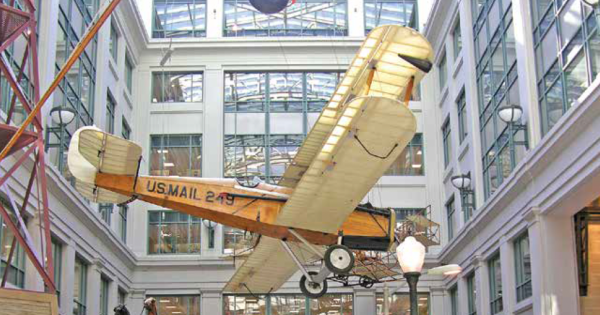The National Postal Service Museum: A Beacon of Postal Service Research
The National Postal Service Museum: A Beacon of Postal Service Research
By Jordanna Garland
Freelance Writer for APG Chesapeake
Photos courtesy of National Postal Museum, Smithsonian Institution
Located just 20 minutes from the White House sits the Smithsonian’s National Postal Museum, home to the vastly rich history of the Postal Service. The museum invites visitors to delve into the culture of the Postal Service with its 14 exhibitions highlighting its dedication to philately research.
Having worked at the museum for nearly 20 years, Curator Lynn Heidelbaugh researches various topics and collections related to philately. As a public historian, Heidelbaugh was drawn to research the Postal Service because it touches on so many aspects of the American experience and our day-to-day lives.

“I can look at very many different topics from how did the customer experience change over time? How did they respond to things like the introduction of parcel post?” Heidelbaugh explained. “There’s always something new for me to find out and that’s what I enjoy.”
Although the museum was established in 1993, the building’s history goes back much further. Formerly known as the City Post Office, the Postal Square Building once served as Washington’s main post office from 1914 to 1986, before reinventing to become the Smithsonian National Postal Museum seven years later. In 2013, the museum expanded to house larger exhibition spaces with the addition of the William H. Gross Stamp Gallery.
The gallery houses the museum’s National Philatelic Collection, which tells the history of postage stamps and mail throughout time and their impact on mailed communication. In exhibitions such as “World of Stamps” and “Mail Markings,” visitors can see artifacts that include the 1840 Penny Black stamp and a letter mailed aboard the Titanic during its fateful voyage.
The museum offers new exhibits, including permanent and temporary displays. One upcoming exhibit set to debut in 2026 will focus on the work of postage stamp designers, examining how the stamps are designed and how they become postage.
When reminiscing on prior projects at the National Postal Museum, Heidelbaugh described examining World War II military mail as one of her favorite research experiences. When curating an exhibit on victory mail (V-mail), a specialized type of mail that allowed for letters to be photographed onto microfilm, she met two veterans who worked in the V-Mail System during the war.

“It really showed me the intricacies of the postal work, the postal network and why people are doing the work to get the mail to someone,” Heidelbaugh said. “To get that personal insight and their lived experiences really was rewarding and brought a deepening of perspective on that subject.”
In her research, Heidelbaugh continues to learn more about the personal experiences of postal workers. In collaboration with a professor from New York University, Heidelbaugh and Assistant Curator Alison R. Bazylinski, a colleague at the museum, currently are working on an oral history project examining postal workwear and how postal workwear prepares the worker for their position. Together, they collect stories from active and inactive postal workers about their workwear and how their clothing and accessories shape
how they perform their postal responsibilities.


“What it means to go about your daily work in the Postal Service, present yourself and be equipped to do your work in whatever environment you are in,” Heidelbaugh offered. “It’s a great way to get that breadth and depth of the Postal Service. The agency is an amazing workforce in terms of numbers and diversity. We are really striving to get more people to help us out and share their stories.” To bring a more immersive element to the National Postal Museum, the curatorial and media departments have created short, one-minute videos, aptly titled “One-Minute Wonders,” that share backstory information about many of the museum’s various objects. These videos are available to watch on the museum’s YouTube page, SmithsonianNPM, and also are accessible through QR codes found throughout the museum.
The Smithsonian’s National Postal Museum is open daily from 10 a.m. through 5:30 p.m.; entrance admission always is free. For more information, visitors can find its website at https://postalmuseum.si.edu.

“I’ve given some tours where somebody says, ‘I’ve worked with that,’ or we’ve had postal inspectors walking through who said, ‘I worked on that investigation,’” Heidelbaugh said. “We’re hoping there are moments where something will resonate with somebody’s experience.”
NAPS members attending the Legislative Training Seminar in early April should make time to visit this fascinating museum!
Jordanna Garland graduated last year from the University of Delaware with a bachelor’s degree in English. She currently works as a freelance writer for APG Chesapeake, a media company in Easton, MD, as she strives to establish her journalism career.
